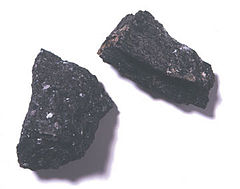Hornblende
| Hornblende | |
|---|---|

Amphibole Hornblende
|
|
| General | |
| Category | Silicate mineral |
|
Formula (repeating unit) |
Ca2(Mg, Fe, Al)5 (Al, Si)8O22(OH)2 |
| Crystal system |
Monoclinic Unknown space group |
| Identification | |
| Color | Black/dark green |
| Crystal habit | Hexagonal/granular |
| Cleavage | Imperfect at 56 and 124 degrees |
| Fracture | Uneven |
| Mohs scale hardness | 5–6 |
| Luster | Vitreous to dull |
| Streak | Pale gray, gray-white |
| Specific gravity | 2.9 |
| Pleochroism | Strong |
Hornblende is a complex inosilicate series of minerals (ferrohornblende – magnesiohornblende). It is not a recognized mineral in its own right, but the name is used as a general or field term, to refer to a dark amphibole.
Hornblende is an isomorphous mixture of three molecules; a calcium-iron-magnesium silicate, an aluminium-iron-magnesium silicate, and an iron-magnesium silicate.
The general formula can be given as (Ca,Na)2–3(Mg,Fe,Al)5(Al,Si)8O22(OH,F)2.
Some metals vary in their occurrence and magnitude:
Hornblende has a hardness of 5–6, a specific gravity of 2.9–3.4 and is typically an opaque green, greenish-brown, brown or black color.
Its cleavage angles are at 56 and 124 degrees. It is most often confused with various pyroxene minerals and biotite mica, which are black and can be found in granite and in charnockite.
Hornblende is a common constituent of many igneous and metamorphic rocks such as granite, syenite, diorite, gabbro, basalt, andesite, gneiss, and schist.
It is the principal mineral of amphibolites. Very dark brown to black hornblendes that contain titanium are ordinarily called basaltic hornblende, from the fact that they are usually a constituent of basalt and related rocks. Hornblende alters easily to chlorite and epidote.
...
Wikipedia
